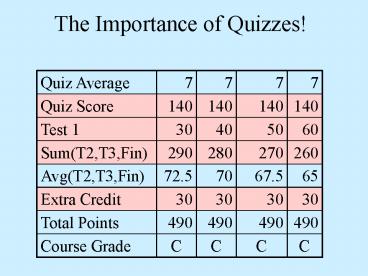The Importance of Quizzes - PowerPoint PPT Presentation
1 / 10
Title:
The Importance of Quizzes
Description:
In statistical inference, it is important to know whether some feature of a ... estimated as the number of grains of sand on the beach at Coney Island (New York) ... – PowerPoint PPT presentation
Number of Views:19
Avg rating:3.0/5.0
Title: The Importance of Quizzes
1
The Importance of Quizzes!
2
Chapter Three Sampling Distribution of the
Count 1. EXAMPLES OF PROBABILITY
DISTRIBUTIONS In statistical inference, it is
important to know whether some feature of a
sample is likely or unlikely routine or
surprising. To assess this, we need to consider
all possible sample arrangements of a certain
size from the population in question. The sample
A, B, C is a set of subjects which have several
arrangements ABC, ACB, BAC, BCA, CAB, CBA which
display different order.
3
The count of possible sample arrangements is
enormous in any practical case. Consider sample
arrangements of size 10 from a population of 100
subjects. If repetition is allowed, there are
10010 1020 possible sample
arrangements this has been estimated as the
number of grains of sand on the beach at Coney
Island (New York). Even if repetition is not
allowed, the above example still has about 60 as
many possible sample arrangements. That is a lot
of sand, and the numbers are routinely much
larger. Therefore we will illustrate the ideas
in this chapter with small samples from small
populations.
4
EXAMPLE A As a trivial example, consider a
population of N4 subjects A,B,C,D. If we
choose a sample of size n3 without replacement
(no repetitions), there are 24 possible sample
arrangements.
5
No repetitions are allowed, and we distinguish
different orders of the same sample. We usually
choose one subject at a time, to be in the
sample thus ACD and DAC are two different
arrangements of the same sample A, C, D.
List the levels x of the count X of A's in
each arrangement, with the fraction of
arrangements which have scores at each level. We
call these fractions probabilities, generalizing
the probability discussed in Chapter Two. This
pair of lists is called a probability
distribution for the sample count X.
The next slide shows what happens if we sample
with replacement.
6
(No Transcript)
7
Again we list the levels x of the count X of
the A's in each arrangement, with the fraction of
arrangements which have scores at each level. We
call these fractions probabilities and express
them with a P. This pair of lists is called a
probability distribution for the sample count X.
8
AS PRACTICE, consider a population of N4
subjects A,B,C,D. If we choose a sample of size
n2 without replacement (no repetitions), there
are 12 possible sample arrangements.
9
AS PRACTICE, consider a population of N4
subjects A,B,C,D. If we choose a sample of size
n2 without replacement (no repetitions), there
are 24 possible sample arrangements.
The next slide shows what happens if we sample
with replacement.
10
(No Transcript)











![get⚡[PDF]❤ 250 Quizzes For Couples: How Well Do You Really Know Me? Fun Questions To PowerPoint PPT Presentation](https://s3.amazonaws.com/images.powershow.com/10081211.th0.jpg?_=20240718014)



















